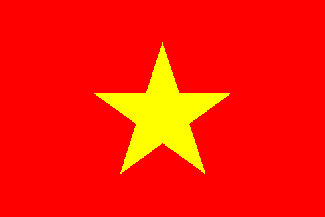
It has been almost three decades since the war ended and in that time virtually all war damage has been repaired. The ruins of this Catholic church have been left untouched as a reminder of what war does.

The interior of the ruined church. Its architecture was cross-shaped, and at the center you can see the raised platform where the altar stood. Above the altar, on the ceiling, is a placard on which one can make out "INRI" -- Latin for Jesus of Nazareth, King of the Jews." This portion of route 1 in Quang Tri province was the scene of intense fighting in 1972.

Today, the government battles other problems. This poster opposes pornography.

The Ben Hai river used to mark the border between North and South Vietnam. From the north side, an arch frames the bridge that crossed the river. Arch and bridge have been restored as a memorial. Traffic now uses a modern highway bridge nearby.

Another view south across the Ben Hai river, looking into south Vietnam from the north.

On the north side of the river a concrete platform used to house some fortification. Now it is being overtaken by flowers.

The Vinh Moc tunnels were an extensive complex by the sea several miles north of the DMZ. The tunnels permitted Vietnamese personnel and their familes to survive during times of intensive bombing. Now one can walk through the tunnels, and in side tunnels, models of Vietnamese engaged in various activities have been made to illustrate their use. This is a "family room".

Camp Carroll was a Marine Base just south of the DMZ. Now it is merely an open field.

We find four circular concrete platforms, each made up of rectangular slabs of concrete. We conclude that American artillery did not require concrete for set up and that these may have been left by the French.

Farther to the west, we stop at the "Rockpile", the hill before us which was contested -- and abandoned -- by the Marines several times.

Many of the casualties treated at Beth Marie's hospital ship came from here. We light some incense to memorialize the dead of all sides.

The westernmost part of today's excursion is the former Marine base at Khe Sanh. We are almost to the Laotian border, and have passed through a customs post marking the "Khe Sanh - Lao Economic Free Trade Zone." The road past Khe Sanh is now a major highway carrying commerce between Vietnam and Laos. Today's English language newspaper tells of this being part of a trans-Asia highway, and expresses the hope that one day people in Northeast Thailand may use this highway for a day trip to Vietnam's beaches.
All that is left of the Khe Sanh base is the red dirt of the airstrips. This is the 1972 airstrip; the earlier airstrip of the famous seige is farther forward from where the photographer is standing. To the right, the Vietnamese have built a museum.

The museum at Khe Sanh has various war relics from the area -- and elsewhere. The sense of history is not very exact. While Khe Sanh was a Marine base, the period aircraft obtained by the museum consists of a U. S. Army Chinook and a U. S. Air Force Light Observation Helicopter.
It has grown dark, and we return to Hue.

